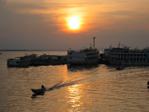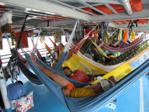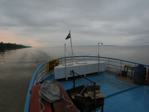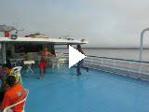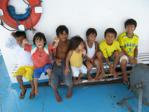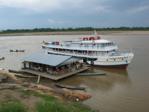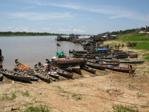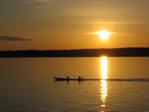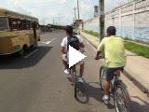From the city of Manaus, I biked to the river port, where I found a boat headed upriver towards Peru. A space to put a hammock and food for six days of travel cost $100. I purchased a ticket, a hammock, and then made friends with a Colombian-Spanish couple who had a cabin on the boat and would guard my valuables while I slept in my hammock.
The river here is enormous — in Manaus, 1,000 miles upstream from the Amazon’s mouth, the river is already by far the world’s largest river (over 150,000 cubic meters of water per second), and over 300 feet deep. Manaus is a large city of 3 million people, yet the other side of the river is almost unpopulated.
My boat followed the largest of the Amazon tributaries (sometimes called the Solimoes, sometimes called the Amazon), upstream towards Peru (see map). To maintain sanity while on the boat, I woke up every day at sunrise and ran laps on the deck (see video, center— I had company). This was followed by a shower, reading until lunch, lunch, more reading, a nap until dinner, dinner, and then talking with other people on the boat until bedtime. It was a demanding schedule.
The boat did make a few stops in small towns along the way, unloading goods and picking up passengers. Most of the riverside, however, was unpopulated.
Arriving upstream, Peru, Colombia, and Brazil’s borders all meet, and in the course of a day, I visited all three before boarding another boat, this time a high speed cruiser (shown left below) to take a one day trip to Iquitos (map). Iquitos, with half a million inhabitants, is the world’s largest inland city with no roads to it — you can get there only by boat or plane. In the late 1800s, the town experienced a brief boom from rubber production, which produced a number of now-historic buildings in the town’s center.
I intended to go to the fire station to ask if I could stay there, but never made it, as two families offered me a place to stay first. Unable to choose between them, I resolved the problem by staying three days, giving me enough time to also visit two schools and appear in the local paper. I also received a tour of the town from three high school students, and also visited an AIDS clinic (perhaps one of the saddest parts of this trip) with a group working for the Catholic Church.
From Iquitos, I took a two and a half day trip upriver to Yurimaguas. The trip–food included–cost less than 30 dollars, and only after paying did I realize that I had paid for first class hammock space — second class, in the floor below, cost 15 dollars.
I have now arrived in Yurimaguas, a small city in the jungle, thus ending my two weeks of boat travel on the world’s largest river system. From here there are a series of small dirt roads that I will be able to follow southwest and into the Peruvian Andes.





